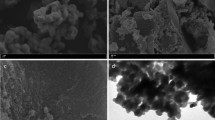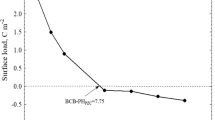Abstract
Two sphalerite samples with different iron/sulphur (Fe/S) ratios, Shuikousan ore (Fe/S 0.2) and Dachang ore (Fe/S 0.52), were processed using three microbial species, Leptospirillum ferriphilum, Acidithiobacillus ferrooxidans and Acidithiobacillus caldus. Following 20 days of bioleaching in shake flask cultures, a higher zinc (Zn) extraction (96%) was achieved with Shuikousan ore than with Dachange ore (72%). The extraction efficiency increased when elemental S was added to Dachang ore to attain the same Fe/S ratio as that for Shuikousan ore. Following the addition of S, the redox potential, pH and total dissolved Fe for Dachang ore demonstrated similar behaviors to those of Shuikousan ore. Acidithiobacillus caldus and L. ferriphilum became the dominant species during the bioleaching of sphalerite with a high Fe/S ratio. In contrast, the dominant species were A. ferrooxidans and A. caldus during the bioleaching of sphalerite with a low Fe/S ratio. These results show that the Fe/S ratio has a significant influence on the bioleaching behavior of sphalerite and the composition of the microbial community.








Similar content being viewed by others
References
Souza AD, Pina PS, Leao VA (2007) Bioleaching and chemical leaching as an integrated process in the zinc industry. Miner Eng 20:591–599. doi:10.1016/j.mineng.2006.12.014
Deller G (2005) World zinc supply and demand-heading for a late-decade price spike. In: Umetsu Y (ed) Lead & zinc’05. TMS, Warrendale, pp 17–25
Akcil A (2004) Potential bioleaching developments towards commercial reality: Turkish metal mining’s future. Miner Eng 17:477–480. doi:10.1016/j.mineng.2003.10.016
Deveci H, Akcil A, Alp I (2004) Bioleaching of complex zinc sulphides using mesophilic and thermophilic bacteria: comparative importance of pH and iron. Hydrometallurgy 73:293–303. doi:10.1016/j.hydromet.2003.12.001
Deveci H (2002) Effect of salinity on the oxidative activity of acidophilic bacteria during bioleaching of a complex Zn/Pb sulfide ore. Eur J Min Process Environ Prot 2:141–150
Harvey TJ, Holder N, Stanek T (2002) Thermophilic bioheap leaching of chalcopyrite concentrates. Eur J Min Process Environ Prot 2:253–263
Mousavi SM, Yaghmaei S, Vossoughi M, Jafari A, Hoseini SA (2005) Comparison of bioleaching ability of two native mesophilic and thermophilic bacteria on copper recovery from chalcopyrite concentrate in an airlift bioreactor. Hydrometallurgy 80:139–144. doi:10.1016/j.hydromet.2005.08.001
Akcil A, Ciftci H (2003) Bacterial leaching of Kure copper ore. J Chamb Min Eng Turk 42:15–26 In Turkish
**a LX, Liu JS, **ao L, Zeng J, Li BM, Geng MM, Qiu GZ (2008) Single and cooperative bioleaching of sphalerite by two kinds of bacteria-Acidithiobacillus ferriooxidans and Acidithiobacillus thiooxidans. Trans Nonferrous Metab Soc China 18:190–195. doi:10.1016/S1003-6326(08)60034-5
Rodríguez Y, Ballester A, Blázquez ML, González F, Muñoz JA (2003) New information on the chalcopyrite bioleaching mechanism at low and high temperature. Hydrometallurgy 71:47–56. doi:10.1016/S0304-386X(03)00173-7
Yin H, Cao L, Qiu G, Wang D, Kellogg L, Zhou J, Dai Z, Liu X (2007) Development and evaluation of 50-mer oligonucleotide arrays for detecting microbial populations in acid mine drainages and bioleaching systems. J Microbiol Methods 70:165–178. doi:10.1016/j.mimet.2007.04.011
He ZG, **ao SM, **e XF, Hu YH (2008) Microbial diversity in acid mineral bioleaching systems of Dongxiang copper mine and Yinshan lead–zinc mine. Extremophiles 12:225–234. doi:10.1007/s00792-007-0130-x
Bond PL, Druschel GK, Banfield JF (2000) Comparison of acid mine drainage microbial communities in physically and geochemically distinct ecosystems. Appl Environ Microbiol 66:4962–4971. doi:10.1128/AEM.66.11.4962-4971.2000
Wulf DD, Bryant LJ, Sly LI (1997) PCR-mediated detection of acidophilic, bioleaching-associated bacteria. Appl Environ Microbiol 63:2944–2948
Zhou J, Bruns MA, Tiedje JM (1996) DNA recovery from soils of diverse composition. Appl Environ Microbiol 62:316–322
Lane DJ (1991) 16S/23S rDNA sequencing. In: Stackebrandt E, Goodfellow M (eds) Nucleic acid techniques in bacterial systematics. Wiley, Chichester, pp 115–175
**a L, Zeng J, Ding J, Yang Y, Zhang B, Liu J, Qiu G (2007) Comparison of three induced mutation methods for Acidiothiobacillus caldus in processing sphalerite. Miner Eng 20(14):1323–1326. doi:10.1016/j.mineng.2007.07.010
Daoud J, Karamanev D (2006) Formation of jarosite during Fe2+ oxidation by Acidithiobacillus ferrooxidans. Miner Eng 19:960–967. doi:10.1016/j.mineng.2005.10.024
Jensen AB, Webb C (1995) Ferrous sulfate oxidation using Thiobacillus ferrooxidans: a review. Process Biochem 30:225–236. doi:10.1016/0032-9592(95)95721-T
Rawlings DE, Tributsch H, Hansford GS (1999) Reasons why ‘Leptospirillum’-like species rather than Thiobacillus ferrooxidans are the dominant iron-oxidizing bacteria in many commercial processes for the biooxidation of pyrite and related ores. Microbiology 145:5–13
Rawlings DE, Coram NJ, Gardner MN, Deane SM (1999) Thiobacillus caldus and Leptospirillum ferrooxidans are widely distributed in continuous-flow biooxidation tanks used to treat a variety of metal-containing ores and concentrates. In: Amils R, Ballester A (eds) Biohydrometallurgy and the environment toward the mining of the 21st century, Part A. Elsevier Press, Amsterdam, pp 777–786
Kinnunen HM, Puhakka JA (2005) High-rate iron oxidation at below pH 1 and at elevated iron and copper concentrations by a L. ferriphilum dominated biofilm. Process Biochem 40:3536–3541. doi:10.1016/j.procbio.2005.03.050
Acknowledgments
This work was supported by the National Science Founding Group (20803094, 50621063), National Basic Research Program of People’s Republic of China (No. 2004CB619204), and FANEDD (200549).
Author information
Authors and Affiliations
Corresponding authors
Rights and permissions
About this article
Cite this article
**a, L., Dai, S., Yin, C. et al. Comparison of bioleaching behaviors of different compositional sphalerite using Leptospirillum ferriphilum, Acidithiobacillus ferrooxidans and Acidithiobacillus caldus . J Ind Microbiol Biotechnol 36, 845–851 (2009). https://doi.org/10.1007/s10295-009-0560-9
Received:
Accepted:
Published:
Issue Date:
DOI: https://doi.org/10.1007/s10295-009-0560-9




